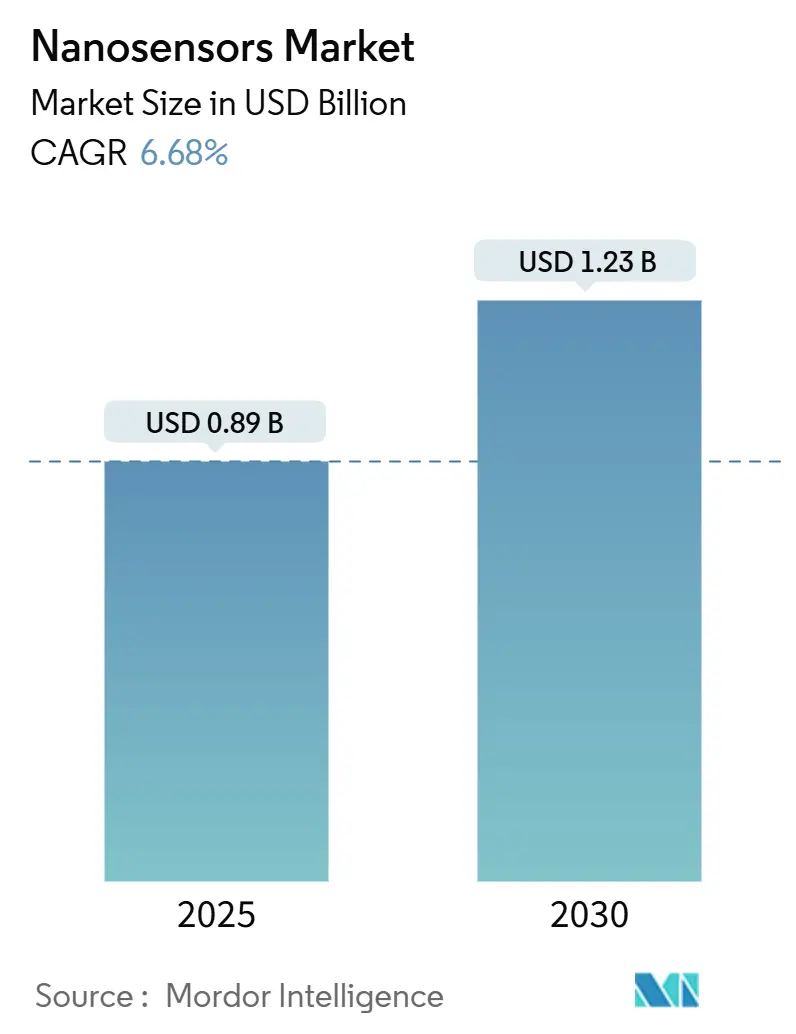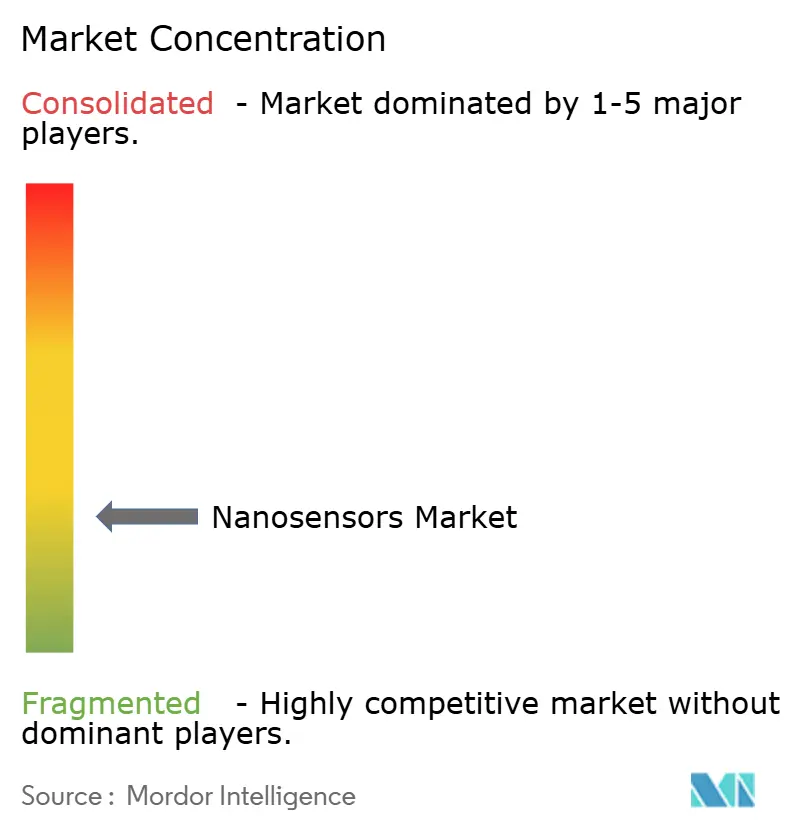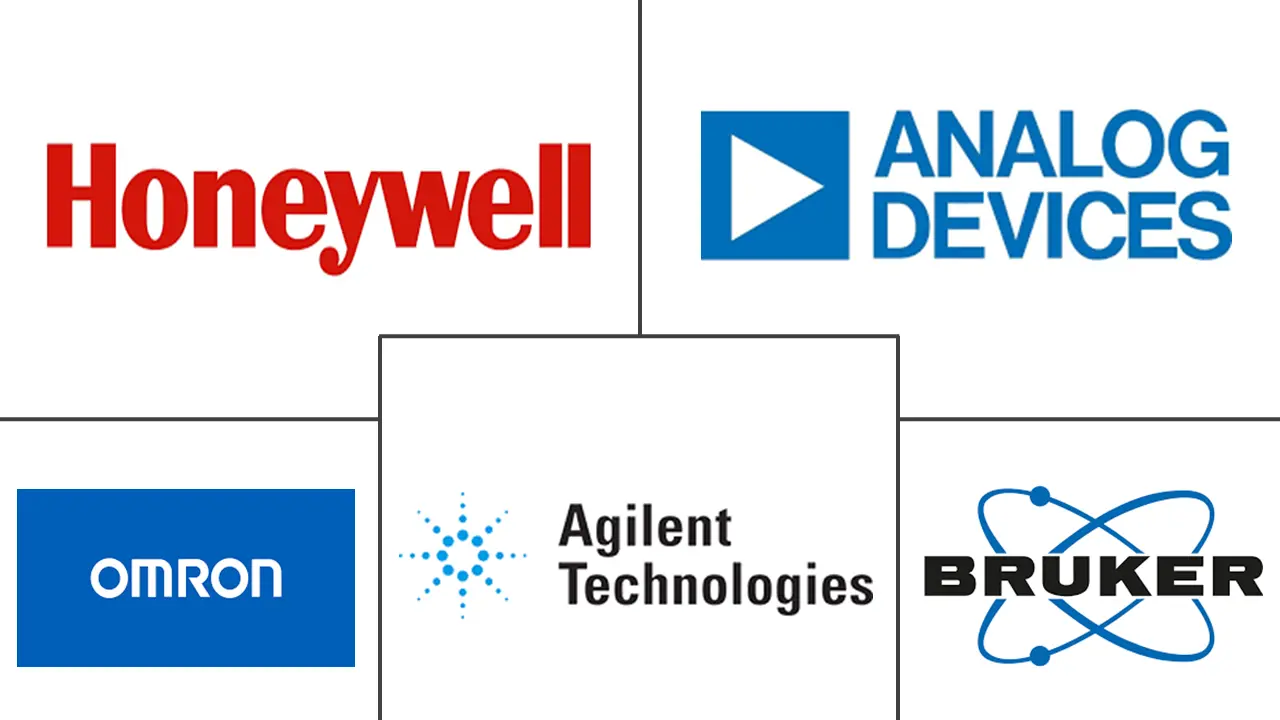
Nanosensors Market Analysis by Mordor Intelligence
The nanosensors market size is estimated at USD 0.89 billion in 2025 and is projected to reach USD 1.23 billion by 2030, growing at a 6.68% CAGR. This growth rests on three pillars: miniaturization pressures across electronics and healthcare, steep cost declines in quantum dot fabrication, and the widening adoption of predictive maintenance IoT systems. Government nanotechnology programs, point-of-care diagnostic rollouts, and defense demand for trace-explosive detection continue to broaden the addressable nanosensors market. Competitive intensity is rising as semiconductor leaders integrate vertically to secure a single-wall carbon nanotube supply, while niche developers focus on ultra-selective biochemical sensing. Simultaneously, regulators are drafting nano-toxicology guidelines that could accelerate product clearances once finalized.
Key Report Takeaways
- By type, chemical nanosensors held 33.2% of the nanosensors market share in 2024, while physical nanosensors posted the fastest 7.4% CAGR through 2030.
- By end-use, healthcare led with a 37.5% revenue share in 2024; the aerospace and defense sector is projected to expand at an 8.1% CAGR through 2030.
- By technology, electrochemical platforms commanded a 28.9% share of the nanosensors market size in 2024, and electromagnetic approaches are expected to advance at a 7.6% CAGR through 2030.
- By geography, North America contributed 31.4% of the revenue in 2024, whereas the Asia-Pacific is set to grow at an 8.2% CAGR between 2025 and 2030.
Global Nanosensors Market Trends and Insights
Drivers Impact Analysis
| DRIVER | (~) % IMPACT ON CAGR FORECAST | GEOGRAPHIC RELEVANCE | IMPACT TIMELINE |
|---|---|---|---|
| Miniaturization of electronics and wearables integration | +1.2% | Asia-Pacific, North America | Medium term (2-4 years) |
| Government-funded nanotech research programs | +0.9% | North America, Europe, China | Long term (≥ 4 years) |
| Rapid expansion of point-of-care diagnostics | +1.1% | Developed markets | Short term (≤ 2 years) |
| Surge in industrial predictive-maintenance IoT deployments | +0.8% | North America, Europe, Asia-Pacific | Medium term (2-4 years) |
| Defense demand for trace-explosive and CBRN detection | +0.7% | North America, Europe, select Asia-Pacific | Long term (≥ 4 years) |
| Quantum-dot cost curve improvements | +0.6% | Global, Asia-Pacific production hubs | Medium term (2-4 years) |
| Source: Mordor Intelligence | |||
Miniaturization of Electronics and Wearables Integration
Consumer and medical device makers are embedding sub-100 nm sensing elements that track biomarkers without enlarging device form factors. Apple’s latest health watch integrates nanosensor arrays for continuous glucose and oxygen-saturation monitoring, illustrating commercial readiness and spurring a USD 200 million incremental addressable revenue by 2027.[1]Source: Apple Inc., Form 10-K 2024, sec.gov Samsung patent filings point to real-time allergen detection in smartphones, while aerospace components adopt nanosensors to measure strain in space-constrained environments. Faster FDA reviews for wearable medical devices shorten launch cycles, allowing innovators to capture early-mover advantages.
Government-Funded Nanotech Research Programs
Public spending anchors long-range demand. The U.S. National Nanotechnology Initiative earmarked USD 1.8 billion in 2024, with nearly one-quarter of the funding allocated to sensing research.[2]Source: “National Nanotechnology Initiative Strategic Plan Update,” National Science Foundation, nsf.gov China’s 14th Five-Year Plan and the EU’s Horizon Europe pour matching resources into quantum-dot and carbon-nanotube facilities, creating reliable demand for nanosensor substrates. Defense agencies treat the technology as strategic, insulating budgets even in downturns and ensuring a steady pipeline of procurement contracts.
Rapid Expansion of Point-of-Care Diagnostics
Decentralized testing requires lab-level sensitivity at the patient's bedside. Electrochemical nanosensors now detect troponin and C-reactive protein at the single-molecule level, reducing cardiac-event diagnosis time from hours to minutes.[3]Source: “Single-Molecule Detection Using Electrochemical Nanosensors,” Nature Biotechnology, nature.com Abbott’s FDA-approved glucose monitor validates commercial feasibility, and nanosensor-enabled devices captured 12% of the USD 45 billion point-of-care segment in 2024. Rural clinics rely on portable instruments that deliver blood-panel results without relying on central labs, while regulators craft expedited pathways for breakthrough diagnostic hardware.
Surge in Industrial Predictive-Maintenance IoT Deployments
Wind-turbine fleets, automotive lines, and chemical plants integrate nanosensors that detect vibration anomalies, gas leaks, and thermal spikes earlier than macro-scale sensors. General Electric's field trials reduced unplanned maintenance by 35% in 2024.[4]Source: GE Renewable Energy, Annual Report 2024, ge.com Siemens and Honeywell now bundle nanosensor modules with analytics software, positioning for subscription revenue tied to uptime gains. Emerging ISO standards will integrate nanosensor specifications into procurement templates, thereby reinforcing their adoption.
Restraints Impact Analysis
| RESTRAINT | (~) % IMPACT ON CAGR FORECAST | GEOGRAPHIC RELEVANCE | IMPACT TIMELINE |
|---|---|---|---|
| Complex nanofabrication scalability bottlenecks | -1.4% | Global, Asia-Pacific fabs | Medium term (2-4 years) |
| Regulatory lag on nano-toxicology standards | -0.8% | North America, Europe | Long term (≥ 4 years) |
| Signal drift in high-humidity field environments | -0.6% | Tropical/coastal regions | Short term (≤ 2 years) |
| Supply-chain concentration of high-purity SWCNTs | -0.9% | Global, Asia-Pacific sources | Medium term (2-4 years) |
| Source: Mordor Intelligence | |||
Complex Nanofabrication Scalability Bottlenecks
Sub-50 nm lithography demands extreme-ultraviolet tools that cost USD 200 million each, pressing capital budgets and capping global output capacity. Yield rates remain below 60%, which is three times lower than the standard for semiconductor lines, thereby inflating unit economics. TSMC’s public disclosures reveal defect-density hurdles that triple production costs versus projected metrics. These constraints force blended architectures that dilute the performance edge of fully nanoscale solutions.
Regulatory Lag on Nano-Toxicology Standards
The FDA, EMA, and other regulatory bodies have yet to establish long-term biocompatibility testing protocols for quantum dots or carbon nanotubes, which can add 18 months to average approval timelines.[5]Source: “Nanotechnology Guidance Documents,” U.S. Food and Drug Administration, fda.gov Environmental-impact assessments remain unresolved, elevating liability concerns for industrial deployments. Manufacturers must conduct bespoke toxicology studies, which elevate pre-market expenses and extend payback periods.
Segment Analysis
By Type: Chemical Sensors Anchor Clinical Applications
Chemical nanosensors held a dominant 33.2% share of the nanosensors market in 2024, driven by strong uptake in medical diagnostics and environmental testing. Physical variants registered a 7.4% CAGR, the fastest in class, fueled by aerospace demand for high-resolution pressure and strain measurement. Biological nanosensors occupy a niche in precision therapeutics, leveraging single-molecule detection for the monitoring of drugs. Hybrid devices now merge chemical selectivity with biological specificity, as evidenced by Abbott prototypes that simultaneously screen multiple biomarkers. Regulatory familiarity with analytical chemistry provides chemical nanosensors with a smoother path to approval, while mechanical engineering standards expedite the deployment of physical sensors.
In parallel, advanced surface-functionalization methods blur category lines, enabling cross-disciplinary applications. Physical sensors benefit from maturing MEMS processes that cut per-unit costs, drawing interest from automotive OEMs. Chemical devices remain favored in water-quality monitoring where molecular discrimination is crucial. Biological nanosensors continue to target intensive-care environments that justify premium pricing.

Note: Segment shares of all individual segments available upon report purchase
By End-Use Verticals: Healthcare Leads, Defence Accelerates
Healthcare commanded 37.5% of the nanosensors market revenue in 2024 due to the constant demand for early disease detection and the management of chronic conditions. Aerospace and defense will post the highest 8.1% CAGR through 2030, propelled by chemical-threat detection mandates and autonomous-navigation upgrades. Consumer electronics offer steady volume potential via smartphones and wearables, though unit pricing is tighter. Automotive adopters focus on emission monitoring and predictive-maintenance gains, while utilities pilot grid-integrity nanosensors.
Reimbursement frameworks and intellectual-property protection sustain healthcare’s premium pricing. Defense contracts ensure a steady volume for specialized trace-explosive detectors. Smartphone leaders validate consumer use cases, nudging suppliers toward lower-cost, high-volume lines. Automotive growth awaits stricter emission rules that would make nanosensor packages mandatory.
By Technology: Electrochemical Dominance Under Electromagnetic Pressure
Electrochemical designs captured 28.9% of the 2024 nanosensors market size, leveraging decades-old electroanalytical foundations that scale well to nanometer dimensions. Electromagnetic alternatives are expected to grow at a 7.6% annual rate through 2030, as wireless power transfer eliminates the need for physical connectors in implants and harsh-environment nodes. Optical nanosensors maintain leadership in applications that require spectroscopic fingerprinting, while piezoelectric and nanomechanical solutions address specialized force- and displacement-measurement niches.
Texas Instruments’ recent capex outlay demonstrates commercial confidence in electromagnetic platforms, especially for battery-less medical implants. Optical devices face cost barriers but excel in pharmaceutical quality control, where selectivity trumps price sensitivity. The technology race is consolidating around electrochemical and electromagnetic modalities that strike a balance between performance and manufacturability.

Note: Segment shares of all individual segments available upon report purchase
Geography Analysis
North America generated 31.4% of the nanosensors market revenue in 2024, driven by defense contracts, FDA-approved medical devices, and a robust venture funding ecosystem. The U.S. Department of Defense alone budgeted USD 340 million for nanosensor research and development in 2024. Canada’s quantum-dot plants and Mexico’s cost-efficient electronics assembly complement the region’s supply chain. Regulatory fast-track programs expedite market entry, but stringent environmental rules impose significant compliance costs.
Asia-Pacific is projected to expand at an 8.2% CAGR through 2030, narrowing the gap with North America. China’s USD 2.3 billion sensor initiative, Japan’s Society 5.0 smart-city agenda, and South Korea’s K-Semiconductor Belt foster domestic fabrication lines. Lower operating costs attract global outsourced manufacturing. Singapore and Taiwan supply high-precision assemblies, while India positions for aftermarket services and calibration.
Europe maintains solid demand from automotive and industrial players, with Germany spearheading vehicle emission sensing and the Netherlands focusing on scientific instrumentation. REACH regulations prolong certification cycles, yet they reward suppliers who are well-versed in compliance. France and the United Kingdom channel research funds into defense-aligned nanosensor programs. The Middle East and Africa exhibit a nascent uptake in oil-field monitoring, where nanosensor durability yields premium margins. South America lags, confined to specialized mining and environmental remediation pilots.

Competitive Landscape
Texas Instruments, STMicroelectronics, and Samsung leverage large-scale fabs to undercut smaller rivals on cost per die. Applied Nanodetectors, Universal Biosensors, and other specialists excel in ultra-specific performance metrics, such as single-digit parts-per-billion gas detection. Vertical partnerships intensify as material suppliers and device makers secure long-lead-time feedstocks for quantum dots and carbon nanotubes.
Honeywell and Siemens package nanosensors with analytics software, capturing recurring service fees. Patent filings reveal a concentration in electrochemical architectures, while electromagnetic sensing is producing a growing IP frontier. Environmental-monitoring durability gaps present white-space opportunities for newcomers that can ruggedize nanosensor housings. Overall, competitive advantage now depends on integrating materials science, chip design, and data interpretation into coherent platforms, rather than discrete parts.
Nanosensors Industry Leaders
-
Agilent Technologies Inc.
-
Analog Devices Inc.
-
Honeywell International Inc.
-
OMRON Corporation
-
Bruker Corporation
- *Disclaimer: Major Players sorted in no particular order

Recent Industry Developments
- September 2024: Texas Instruments allocated USD 85 million to expand nanosensor output at its Richardson, Texas, campus, adding a quantum-dot assembly line with an annual capacity of 10 million units.
- August 2024: Samsung’s continuous glucose nanosensor earned FDA breakthrough designation, paving the way for a 2025 commercial debut.
- July 2024: STMicroelectronics acquired Applied Nanodetectors for USD 120 million, augmenting its gas-detection portfolio for automotive clients.
- June 2024: Honeywell launched a wireless industrial nanosensor suite delivering five-year battery life for predictive-maintenance use cases.
Global Nanosensors Market Report Scope
| Biological Nanosensors |
| Chemical Nanosensors |
| Physical Nanosensors |
| Healthcare |
| Consumer Electronics |
| Aerospace and Defence |
| Automotive and Industrial |
| Power Generation |
| Other End-user Verticals |
| Electrochemical |
| Optical |
| Electromagnetic |
| Piezoelectric |
| Nanomechanical |
| North America | United States | |
| Canada | ||
| Mexico | ||
| South America | Brazil | |
| Argentina | ||
| Rest of South America | ||
| Europe | Germany | |
| United Kingdom | ||
| France | ||
| Italy | ||
| Spain | ||
| Russia | ||
| Rest of Europe | ||
| Asia-Pacific | China | |
| Japan | ||
| India | ||
| South Korea | ||
| South-East Asia | ||
| Rest of Asia-Pacific | ||
| Middle East and Africa | Middle East | Saudi Arabia |
| United Arab Emirates | ||
| Rest of Middle East | ||
| Africa | South Africa | |
| Egypt | ||
| Rest of Africa | ||
| By Type | Biological Nanosensors | ||
| Chemical Nanosensors | |||
| Physical Nanosensors | |||
| By End-use Verticals | Healthcare | ||
| Consumer Electronics | |||
| Aerospace and Defence | |||
| Automotive and Industrial | |||
| Power Generation | |||
| Other End-user Verticals | |||
| By Technology | Electrochemical | ||
| Optical | |||
| Electromagnetic | |||
| Piezoelectric | |||
| Nanomechanical | |||
| By Geography | North America | United States | |
| Canada | |||
| Mexico | |||
| South America | Brazil | ||
| Argentina | |||
| Rest of South America | |||
| Europe | Germany | ||
| United Kingdom | |||
| France | |||
| Italy | |||
| Spain | |||
| Russia | |||
| Rest of Europe | |||
| Asia-Pacific | China | ||
| Japan | |||
| India | |||
| South Korea | |||
| South-East Asia | |||
| Rest of Asia-Pacific | |||
| Middle East and Africa | Middle East | Saudi Arabia | |
| United Arab Emirates | |||
| Rest of Middle East | |||
| Africa | South Africa | ||
| Egypt | |||
| Rest of Africa | |||
Key Questions Answered in the Report
What is the current size of the global nanosensors market?
The nanosensors market size is USD 0.89 billion in 2025, heading to USD 1.23 billion by 2030.
Which segment grows fastest within nanosensor applications?
The aerospace and defense sector is forecast to post the highest 8.1% CAGR, driven by the need for chemical-threat detection and navigation.
Which technology dominates commercial nanosensors today?
Electrochemical designs lead with 28.9% revenue share, benefiting from mature analytical chemistry foundations.
Why is Asia-Pacific attracting so much nanosensor investment?
Government roadmaps, lower fab costs, and robust electronics supply chains drive an 8.2% CAGR outlook for the region.
What limits nanosensor scale-up in manufacturing?
High-cost extreme-ultraviolet lithography and sub-60% yield rates make scaling difficult and raise per-unit costs.
Page last updated on:



